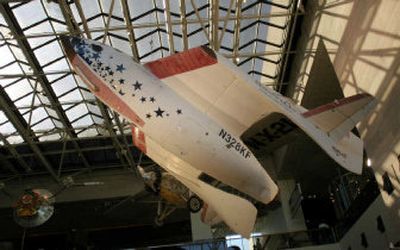Out of this world

WASHINGTON — The Smithsonian Institution’s 2005 National Design Awards were presented Thursday night in New York, but the best of show is on display in a Washington museum.
It’s SpaceShipOne, the extraordinary private rocket dreamed up by Burt Rutan, who won the honor for product design from the Cooper-Hewitt National Design Museum, the Smithsonian’s Manhattan outpost. Since Oct. 5, his gleaming three-passenger spaceship, with its sprinkling of blue stars and round windows, has been on view at the National Air and Space Museum, where it looks frighteningly small and fragile to have gone so far so fast, and with no government funding.
Thursday night’s announcement of Rutan’s design award came a year and 16 days after SpaceShipOne completed its third journey, kazooming into suborbital space at Mach 3 and floating home to the Mojave Desert on flexing wings inspired by a badminton shuttlecock.
That’s as good a definition of cutting-edge design as we’re likely to see in this lifetime.
The adventure cost Microsoft co-founder Paul Allen $24 million. Rutan won $10 million from the X Foundation for his efforts. Now children can look up in awe as guides explain that in the foreseeable future — Virgin founder Richard Branson already has placed an order for five second-generation craft — a new breed of tourist may be able to plunk down cash for a five-minute journey across the threshold of space.
Rutan, who has designed aircraft since the 1960s, was out of the country this week and could not accept the award in person at Thursday night’s gala dinner, according to his office. SpaceShipOne’s design innovations include a wing that folds up during spaceflight and works as a brake on re-entry, and a pressurized cabin. On a videotape at Air and Space, the designer recalls with a decisive snap of his fingers the moment he knew “I had it.” As a design model, the feathers of the shuttlecock were “really out there,” Rutan says, and he acknowledged the possibility that “we are absolutely crazy.”
By contrast, the other five awards announced Thursday night seemed tame, though most of the winners are certifiably avant-garde. For six years the design awards have sought to crystallize a view of the world as an exciting playing field on which imagination is welcome and rules are meant to be challenged, even and especially in the public realm.
Ned Kahn, a Sebastopol, Calif., artist, combines science and art to make installations based on fire, wind and fog. He was honored for landscape design for a portfolio that included “Wind Portal,” an installation of 200,000 mirrored disks that move in air currents created by passersby at the BART station at San Francisco International Airport.
The architecture award winner, Diller, Scofidio + Renfro, a New York firm, focused first on fusing architecture with the visual and performing arts. Founding partners Elizabeth Diller and Ricardo Scofidio received a MacArthur Foundation grant in 1999. (Charles Renfro became a partner later.) Projects now in the works include the expansion and renovation of Lincoln Center, a harbor-front building for Boston’s Institute of Contemporary Art, and the transformation of a disused elevated rail line in Manhattan into a meandering public park. Awards juror Jeff Speck, director of design at the National Endowment for the Arts, noted that the trophy is meant to signal approval of “pushing the limits.”
Several top awards were announced over the summer. The award for lifetime achievement was claimed by Eva Zeisel, the ceramics designer, whose 75-year career has been propelled by what she calls “the playful search for beauty.” Her softly rounded forms are enjoying a revival at Crate & Barrel, and a retrospective including her Soviet-era work is on view at Hillwood Museum & Gardens in Washington through Dec. 4.
Winners receive no cash prize. Instead, they are required to share their thinking in a program of lectures, studio visits and other programming.
At Air and Space, the SpaceShipOne on exhibit is notable for a dent in the underside. Pilot Mike Melvill explained the deformation by phone from Rutan’s company, Scaled Composites, in Mojave, Calif. It was “a badge of honor, so to speak,” caused by an unexpected crush of air on re-entry during the first flight. The problem was fixed but the Smithsonian asked to have the spaceship just as it appeared after the initial journey. Autographs of well-wishers and staff are visible on the nozzle of the rocket motor.
Melvill, who has flown Rutan’s experimental craft for 28 years, describes the designer as a “second edition” of Clarence L. “Kelly” Johnson, a legendary aeronautical engineer who led Lockheed’s “Skunk Works” and designed 40 aircraft, including the U-2 spy plane.
“Kelly Johnson was his idol as a kid,” Melvill says. “Nobody could tell him what to do. Even the government couldn’t get him to bow down. He was abrasive. He was a brilliant designer. Burt’s the same way.”